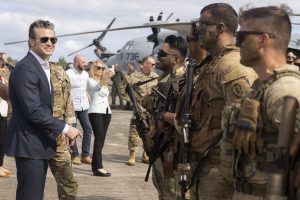Throughout the Joe Biden presidency, it became a common refrain amongst policy analysts that his administration’s approach to foreign policy could be characterized as “America First, with a smile.”
It reflected what many saw as a “strange continuity” in substance, if not style, between the first Trump administration and the Biden era, including on Asia policy. Such constancy gave allies and partners some comfort that U.S. commitment to the region could withstand Trump’s return to the White House.
Trump 2.0, however, is evidently a different beast. Beyond unsettling policy shifts at home, his administration’s pillorying of European partners and its reckless approach to economic policy – including the considerable “Liberation Day” tariffs on many of the United States’ most important Asian partners that were announced this week – has left many rightly worried about the credibility of U.S. Indo-Pacific alliances and the future of U.S. regional strategy more broadly.
Yet amid all the noise, we’ve also had some welcome signs of normalcy on U.S. regional strategy, at least as far as defense is concerned.
Amid the fallout from “SignalGate” and Trump’s tariffs, it was easy to miss U.S. Secretary of Defense Pete Hegseth’s first regional tour last week. Notwithstanding its MAGA idiosyncrasies, the vision presented by Hegseth in Hawaii, the Philippines, and Japan offered welcoming signs of continuity on U.S. regional security commitments.
Indeed, Hegseth’s major policy address in Honolulu was notable for its normalcy. As one colleague quipped to me, stripped of its ideological overtones, it was “a speech that any defense secretary could have given.”
Hegseth insisted that the Indo-Pacific – “the region of consequence” – would remain the United States’ top geographic priority, citing Trump’s 2017 “Indo-Pacific dream” speech in Vietnam as the genesis of that commitment. He reiterated that promise in Manila, declaring that Trump would walk the talk of prioritization “in a way that is unprecedented” through the quality and quantity of U.S. forces assigned to Asia. Granted, successive U.S. defense secretaries since the early 2000s have promised prioritization, but have not delivered in practice. Even so, Hegseth’s was a welcome pledge given regional concerns over the reliability of U.S. security guarantees amid projected troop drawdowns in Europe and growing military distractions in the Middle East.
On China, Hegseth made clear that collective deterrence remains the guiding concept for U.S. defense strategy. Pledges to posture U.S. forces for “warfighting” in that face of “Communist Chinese military aggression” may have struck a confrontational tone. Yet the underlying objective of achieving “robust, ready, and credible deterrence” together with allies and partners is broadly consistent with the Biden administration’s own approach to defense strategy, optimized for “denial, resilience, and collective cost imposition” with China as the “pacing challenge.” Alliances and partnerships also remain central to the Trump version of that strategy. Rather than “ignoring allies and partners,” Hegseth repeatedly stressed throughout his tour that U.S. success in Asia depends on paying “even greater attention to the relationships that matter the most,” noting that “America First does not mean America only.”
Such attention will, naturally, include a laser focus on burden-sharing, given Trump’s fixation on what he sees as free-riding by U.S. treaty allies. Hegseth’s insistence that collective defense “has to be a two-way street” and that Washington will “right-size [alliance] obligations and responsibilities needed for modern deterrence” made that much clear. Other influential Pentagon figures have already dismissed allied defense budgets of anything below 3 percent of GDP as “manifestly inadequate.” Japan’s experience under Trump 1.0 and recent U.S. engagements with European and Asian leaders also suggest that regional allies should expect greater pressure to buy U.S. weapons under the guise of “empowerment.”
But it’s also clear that Trump’s approach to alliances will, at least at face value, be about more than correcting alliance balance sheets. It will also involve modernizing alliances to equip them with the tools to better contribute to collective security. New force posture and defense industry initiatives announced with Australia, India, Japan, and the Philippines since January 2025, including several during Hegseth’s trip, are strong indicators that Trump will persist with Biden’s alliance modernization agenda, itself built upon the efforts of the first Trump administration.
Efforts to network U.S. regional alliances also appear likely to endure. Indeed, it was no coincidence that Hegseth’s Asia trip took place against the backdrop of trilateral Japan-Philippines-U.S. naval operations in the South China Sea aimed at countering Chinese encroachment. This, along with earlier endorsements of AUKUS and the Quad, which both received great attention under Biden, suggest that the administration is willing to stick with regional security groupings that are delivering practical outcomes.
After a frenetic first three months, Hegseth’s first Asia foray may help U.S. allies and partners in Asia breathe a little easier about America’s regional commitments – for this week, at least.
Yet while the early signs on bilateral defense policy are promising, there remain serious reasons to worry about the non-military tools of U.S. statecraft. Left unaddressed, the gutting of U.S. soft power and the president’s confrontational trade policies will likely undercut early gains, while focusing only on deterring Chinese military aggression could yet alienate key partners across the region. It is also difficult to reconcile Hegseth’s rhetorical commitments to prioritizing defense requirements in Asia with a renewed surge in the Middle East and the tasking of high-end military assets to the southern U.S. border for security operations. Together, all of these factors this would make for a hollow Indo-Pacific strategy.
While Hegseth might have sent the right signals this week, the Trump administration has much to do to in the coming months to show that the return of “America First, with a scowl” in Asia is more than a military equation.

































